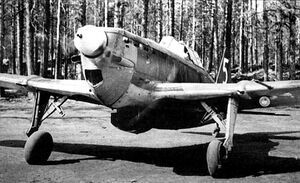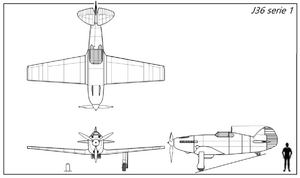Arsenal J 36 Falke
| J 36 Falke | |
|---|---|

| |
| Melasian J 36 Falke with a started engine on an advanced airfield near Humboldtsberg in 1942 | |
| Role | Fighter aircraft |
| National origin | |
| Manufacturer | Arsenal |
| Designer | Erich Krammer |
| First flight | 10 April 1938 |
| Introduction | 1939 |
| Retired | 1961 Melasian air force |
| Status | Retired |
| Primary user | Melasian air force |
| Produced | 1939–1946 |
| Number built | 354 + 3 prototypes |
| Variants | Arsenal J 42 Arsenal J 49 |
The J 36 Falke (hawk) was a Melasian fighter aircraft of the first half of the 20th century. It was designed by Erich Krammer and produced by the Melasian aviation company Arsenal. The aircraft is remarkable for being Melasia's first domestically designed and produced fighter aircraft and the first non-Berean type of combat aircraft to exceed speeds of 400 km/h (200 kn) in a straight level flight. The J 36 was of a mixed semi-monocoque and stressed skin design, built mostly of wood and fabric, with metal used in vital points of the structure like the engine cowling and the rudder fin joint. It also had some advanced features for the period, like the retractable landing gear, the completely enclosed cockpit and the split flaps. The high wingspan and the short fuselage provided a relatively small wing loading, while the light weight of the wooden construction coupled with a powerful V-12 engine allowed for a respectable degree of manoeuvrability.
The J 36 was a result of a fear in high echelons of Melasian government of possible Berean sanctions due to the aggressive Melasian foreign policy in Kenlong and against Mascylla. A tender was called for a lightweight fighter aircraft to replace the aging endargered Melasian air fleet, that consisted of mostly Mascyllary-built machines. The Melasian Ministry of war called for an aircraft equipped with the Lavarian-built Fábrica Automotiva Popular 12Y engine and the Nordic 20mm Oerlikon FF gun, both available after an agreemend was signed between Melasia and the respectable countries earlier 1936. Following a short public tender the variant presented by Arsenal was selected. The aircraft was introduced in 1939 and relatively quickly became the standard Melasian fighter. It served actively during the Melasian Crisis, when it proved to be a potent opponent to earlier Mascyllary aircraft on low altitudes. After the initial stages of the conflict, and the introduction of newer models by the Mascyllary air force, the J 36 began to underperform and was almost withdrawn from frontline service when the conflict seized in 1943. The remaining inventory of J 36s was then used in Kenlong, where it performed anti-guerrilla operations against the various Kenlongese revolutionary groups. The type was withdrawn from frontline service with the Melasian air force in 1949 but remained in the inventory up until the early 1960s.
The J 36 served only with the Melasian air force, although several airframes were transported to Mascylla for evaluation during the Melasian crisis. The slow production rate and the ever-growing international isolation of the country prevented its international export potential, with several states showing interest prior to the crisis being rejected by the Melasian government due to lack of surplus aircraft engines. Several attempts to improve and upgrade the model were performed throughout its service life, with the J 49 seeing the most success and becoming the next standard Melasian fighter.
Development
Background
Further development
Design

Operational history
Melasian crisis
Kenlongese revolution
Variants
- J 36 Serie 0
- Pre-production run of 5 aircraft. The Serie 0 was completed with the earlier Fábrica Automotiva Popular 12Ycrs and two 7.7 mm machine guns in the nose. The construction used plywood as its skin everywhere except for the engine cowling. The aircraft was equipped with a wooden two-blade propeller without pitch control. The variant first flew in September 1937. All 5 aircraft were stored in at the Arsenal factory for various tests. Three were destroyed by Mascyllary bombing runs during the Melasian crisis, with the other two used for spare part cannibalizing until eventually being scrapped.
- J 36 Serie 1
- The first production variant, with several major and minor changes implemented to various systems of the aircraft. Those included, but were not limited to:
- The implementation of aluminium alloy on sections of the fuselage skin to strenghten the construction;
- The usage of the more advanced Fábrica Automotiva Popular 12Ydrs engine;
- Wingspan increase by 24 mm (9.45 in);
- The implementation of a three-blade, all-metal variable-pitch propeller;
- The substitution of the two 7.7 mm machine guns by the locally produced copy of the M2 0.50 cal. machine gun;
- Additional oil cooler in the nose of the aircraft;
The Serie 1 was produced between 1938 and 1941, with the variant being the most numerous in Melasian service at the start of the Melasian crisis. With subpar characteristics even by 1939 standards, it was quickly replaced by more modern variants, with 65 aircraft produced by April 1941.
- J 36 Serie 2
- Noting the numerous drawbacks found after the first months of service in the Melasian air force, Arsenal attempted an upgrade to the J 36 by installing a more reliable and lighter hand pump for the main landing gear as an emergency measure, an additional 80 L fuel tank under the pilot, and provisions for an additional external fuel tank for long range operations. Most of the radio equipment and instruments were replaced, as the earlier variants were equipped with Mascyllary instrumets taken from earlier biplane fighters in service of the Melasian air force and were not suited for the speeds of the J 36. Additionally, most components of Mascyllary origin were replaced with identical ones produced locally or imported from Cuthland, the last Berean power to not have imposed sanctions on Melasia by 1939. 32 aircraft of the type were completed between late 1939 and mid-1941.
- J 36 Serie 3
Operators
- Melasian Air Force operated the type since its introduction in 1939 up until 1961, and used it in the Melasian crisis and during the Kenlongese civil war
- Several aircraft were captured during the Melasian Crisis and shipped to Mascylla for evaluation and trials
Survivors
Specifications
Data from The J 36 type certification sheet
General characteristics
- Crew: 1
- Length: 7.40 m (24 ft 3 in)
- Wingspan: 9.36 m (30 ft 9 in)
- Height: 2.57 m (8 ft 5 in)
- Wing area: 16 m2 (170 sq ft)
- Airfoil: NACA 63(2)-615
- Empty weight: 1,360 kg (2,998 lb)
- Max takeoff weight: 2,460 kg (5,423 lb)
- Fuel capacity: 440 kg (520 L avgas)
- Powerplant: 1 × Fábrica Automotiva Popular 12Y V-12 liquid-cooled piston engine
- 619 kW (830 hp) for take-off at 2,520 rpm at sea level
- 567 kW (760 hp) rated power at 2,400 rpm at sea level
- 641 kW (860 hp) rated power at 2,400 rpm at 3,150 m (10,335 ft)
- Specific fuel consumption: 0.265 kg/kWh (0.436 lb/(hp⋅h))
- Specific oil consumption: 0.008 kg/kWh (0.013 lb/(hp⋅h))
- Propellers: 3-bladed variable-pitch propeller, 3 m (9 ft 10 in) diameter
Performance
- Maximum speed: 442 km/h (275 mph; 239 kn) at 1,500 m (4,900 ft)
- Cruise speed: 380 km/h (236 mph; 205 kn) at 1,500 m (4,900 ft)
- Stall speed: 120 km/h (75 mph; 65 kn) without flaps
- Range: 820 km (510 mi; 443 nmi) at 66% power
- Combat range: 600 km (373 mi; 324 nmi)
- Endurance: 2 hours 30 minutes (average combat mission)
- Service ceiling: 8,000 m (26,000 ft)
- Time to altitude:
- 5,000 m (16,404 ft) in 8 minutes 46 seconds
- Wing loading: 154 kg/m2 (32 lb/sq ft)
- Power/mass: 2.95 kg/kW (4.85 lb/hp)
- Take-off run to 8 m (26 ft): 320 m (1,050 ft)
- Landing run from 8 m (26 ft): 420 m (1,378 ft)
Armament
- Guns:
- 1× 20 mm (0.787 in) Oerlikon FF cannon (60 rounds)
- 2× 12.7 mm (0.500 in) Arsenal M2 machine guns (200 rpg)
See also
Related development
Arsenal J 42
Arsenal J 49
